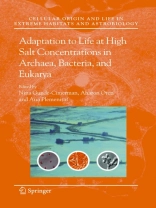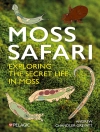Salt is an essential requirement of life. Already from ancient times (e. g. , see the books of the Bible) its importance in human life has been known. For example, salt symbolizes destruction (as in Sodom and Gomorra), but on the other hand it has been an ingredient of every sacrifice during the Holy Temple periods. Microbial life in concentrated salt solutions has fascinated scientists since its discovery. Recently there have been several international meetings and books devoted entirely to halophiles. This book includes the proceedings of the “Halophiles 2004” conference held in Ljubljana, Slovenia, in September 2004 (www. u- lj. si/~bfbhaloph/index. html). This meeting was attended by 120 participants from 25 countries. The editors have selected presentations given at the meeting for this volume, and have also invited a number of contributions from experts who had not been present in Ljubljana. This book complements “Halophilic Microorganisms”, edited by A. Ventosa and published by Springer-Verlag (2004), “Halophilic Microorganism and their Environments” by A. Oren (2002), published by Kluwer Academic Publishers as volume 5 of “Cellular Origins, Life in Extreme Habitats and Astrobiology” (COLE), and “Microbiology and Biogeochemistry of Hypersaline Environments” edited by A. Oren, and published by CRC Press, Boca Raton (1999). Salt-loving (halophilic) microorganisms grow in salt solutions above seawater salinity (~3. 5% salt) up to saturation ranges (i. e. , around 35% salt). High concentrations of salt occur in natural environments (e. g.
Tabella dei contenuti
The environments and their diversity.- Microbial Diversity of Great Salt Lake.- Microbial Communities in the Dead Sea — Past, Present and Future.- Microscopic Examination of Microbial Communities Along a Salinity Gradient in Saltern Evaporation Ponds: A ‘Halophilic Safari’.- The Microbial Diversity of a Solar Saltern on San Francisco Bay.- Diversity of Microbial Communities: The Case of Solar Salterns.- Isolation of Viable Haloarchaea from Ancient Salt Deposits and Application of Fluorescent Stains for in Situ Detection of Halophiles in Hypersaline Environmental Samples and Model Fluid Inclusions.- Hydrocarbon Degradation under Hypersaline Conditions.- The Relevance of Halophiles and other Extremophiles to Martian and Extraterrestrial Environments.- Halophiles: A Terrestrial Analog for Life in Brines on Mars.- Archaea.- Comparative Genomic Survey of Information Transfer Systems in two Diverse Extremely Halophilic Archaea, Halobacterium Sp. Strain NRC-1 and Haloarcula Marismortui.- Walsby’s Square Archaeon.- Gene Regulation and the Initiation of Translation in Halophilic Archaea.- Protein Translation, Targeting and Translocation in Haloferax Volcanii.- Enzymes of Halophilic Archaea.- Osmoadaptation in Methanogenic Archaea: Recent Insights from a Genomic Perspective.- Bacteria.- Salinibacter Ruber: Genomics and Biogeography.- What We Can Deduce about Metabolism in the Moderate Halophile Chromohalobacter Salexigens from its Genomic Sequence.- K+ Transport and its Role for Osmoregulation in a Halophilic Member of the Bacteria Domain: Characterization of the K+ Uptake Systems from Halomonas Elongata.- The Chloride Regulon of Halobacillus Halophilus: A Novel Regulatory Network for Salt Perception and Signal Transduction in Bacteria.- Biosynthesis of the Compatible Solute Mannosylglycerate from Hyperthermophiles to Mesophiles.- Genes and Enzymes of Ectoine Biosynthesis in the Haloalkaliphilic Obligate Methanotroph “Methylomicrobium Alcaliphilum 20Z”.- Halophilic Archaea and Bacteria as a Source of Extracellular Hydrolytic Enzymes.- Biopolyester Production: Halophilic Microorganisms as an Attractive Source.- Fungi.- Relation of Halotolerance to Human-Pathogenicity in the Fungal Tree of Life: An Overview of Ecology and Evolution under Stress.- Halotolerant and Halophilic Fungi from Coastal Environments in the Arctics.- Halotolerant and Halophilic Fungi and Their Extrolite Production.- Introducing Debaryomyces Hansenii, a Salt Loving Yeast.- Cellular Responses in the Halophilic Black Yeast Hortaea Werneckii to High Environmental Salinity.- Halotolerance and Lichen Symbioses.- Algae.- A Century of Dunaliella Research: 1905–2005.- Molecular Determinants of Protein Halotolerance: Structural and Functional Studies of the Extremely Salt Tolerant Carbonic Anhydrases from Dunaliella salina.- Protozoa.- Heterotrophic Protozoa from Hypersaline Environments.- Heterotrophic Flagellates in Hypersaline Waters.- Viruses.- Haloviruses and Their Hosts.












